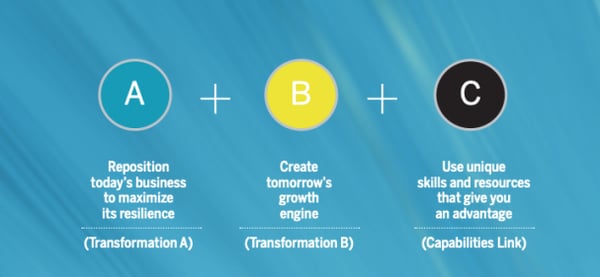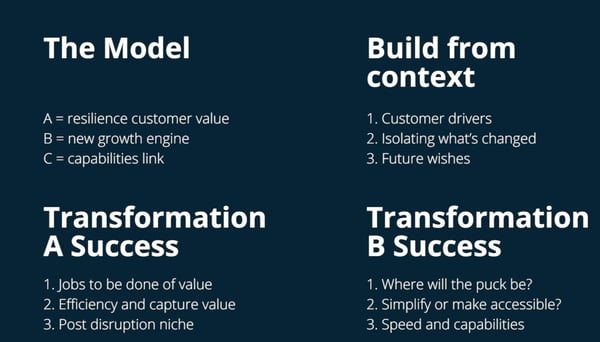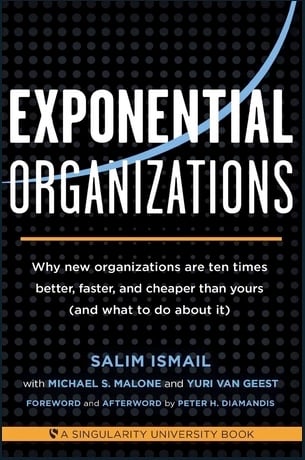UPDATED as of 10 July 2020
In a special interview with Step Change, Dual Transformation co-author Mark W. Johnson shares valuable insight for businesses looking to reposition themselves in this new normal while creating the future ahead of them.
The business model innovation and new growth strategy expert also discusses:
- The A+B+C model business seeking transformation and momentum should adapt
- What successful businesses are doing right and what others are getting wrong in their transformation journey
- The importance of having a vision and a hands-on approach to leadership
Watch the video now.
Disruption is imminent, and organisations must find a way to be more resilient as they step forward into growth and implement their transformation efforts.
In this week’s Knowledge Nuggets, we look into the ideal transformation model that businesses can use to address change and face today’s disruptive forces through the book Dual Transformation by Clark Gilbert, Mark W. Johnson, and Scott D. Anthony.
Insight: Businesses are ignoring the clear signs of disruption— customer habits are changing, brand loyalty is on a worrying decline, and businesses are rushing into venture capital. The arrival of the COVID-19 pandemic has created both medical and financial crisis that fuel the growth of disruption.
Data: New research of 505 medium to large Australian businesses, commissioned by Microsoft Australia, shows the vast majority of those businesses are aware of the need to digitally transform their businesses (Business Insider). However, many of those surveys are resilient to change
What’s the step change: Tap into the forces at work behind today’s disruptors to reposition your business today and create tomorrow’s new growth engine. Watch the video below to find out more on how we can apply the key concepts presented in Dual Transformation.
In this episode of Knowledge Nuggets, we will talk about one of my favourite texts, which is Dual Transformation by Scott Anthony et al. Many business people talk about disruption and what technologies are coming, but this text breaks it down and gives organisations an approach to resilience and how we should consider responding to disruption.
Transformation as a Response to Disruption
Many organisations are feeling overwhelmed at the moment. What should I do when facing disruption? This book acknowledges that the situation is complex and the future is full of uncertainty.
The book also cites many case studies from organisations such as Xerox to Johnson&Johnson and Amazon. These are practical examples from which we can learn how to respond to disruption.
The following four points taken from Dual Transformation are worth considering:
1. The Model
This Dual Transformation model is simple but provides real clarity. It states that every organisation must simultaneously go through a dual transformation to survive and be successful in the future.
- A = Resilience customer value. This is the current resilience transformation delivering customer value.
- B = New Growth Engine
- C = Capabilities provide a link that brings it all together

The model is described in clear language. If you can’t pick up and hang on to the value you are adding, then different divisions get confused, parts of the company fall away, and we lose momentum.
2. Build from Context You’re In
This describes building from the context you are currently in. So we look at what the current customer drivers are.
At Step Change, we use triggers, fears, barriers, drivers, and pain points. We use simple language like, “Can you figure out what’s been driving customer buying behaviour?”, “What’s changed around that?” and “What would be the future wants?”
We look through a customer lens of needs, drivers, barriers, pain points and then flip it in the future. It is important to understand that the context is where the strategy should arise from.
Explore further: The Death of the SWOT Analysis and the Rise of the Strategic Radar
3. Success Variables for Transformation A
This is the transformation currently taking place within the core business.
Within your current business, there are customers seeking additional value. Can you project that forward? Can you do that more efficiently so that you can capture more value all the way through to fund Transformation B? Is there a niche you can capture? You don’t have to do everything at once, but if you can achieve that core piece of the work to add value, then maybe there is a niche in the future. That’s the dimensions of Transformation A.
4. Transformation B Success
This is the growth engine transformation which is where we look to see where the puck (ice hockey analogy) will be. If disruption is good news and it levels the playing field, creating new opportunities– where will the puck and the opportunity be? Can we skate to this place? That’s the question for Transformation B.
It also asks the question where is the value going to be created? Value then comes from simplifying the complex or making the previously inaccessible accessible. These are two ways to look at how value will be created in a post-disruption world.
5. Speed of Arriving at Just the Right Time
This falls under the capabilities link within the model. By looking at your current business, can you translate today’s value into the future by leveraging it into your new business?

I think that this is a great model for organisations undergoing a period of transformation.
Remember, A + B + C = success.
The question is, within your strategy, do you have the dimensions of how you are performing now, how new value will be created in the future, and are you preserving your advantage across the two phases?
Download our Knowledge Nugget on Dual Transformation:
















